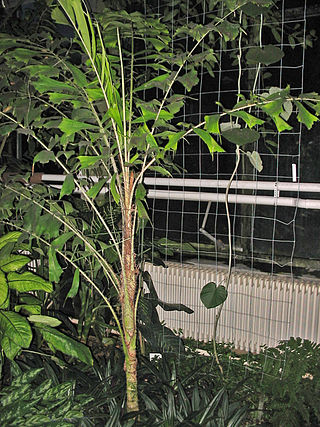
Hevea brasiliensis, the Pará rubber tree, sharinga tree, seringueira, or most commonly, rubber tree or rubber plant, is a flowering plant belonging to the spurge family Euphorbiaceae originally native to the Amazon basin, but is now pantropical in distribution due to introductions. It is the most economically important member of the genus Hevea because the milky latex extracted from the tree is the primary source of natural rubber.

Aiphanes is a genus of spiny palms which is native to tropical regions of South and Central America and the Caribbean. There are about 26 species in the genus, ranging in size from understorey shrubs with subterranean stems to subcanopy trees as tall as 20 metres (66 ft). Most have pinnately compound leaves ; one species has entire leaves. Stems, leaves and sometimes even the fruit are covered with spines. Plants flower repeatedly over the course of their lifespan and have separate male and female flowers, although these are borne together on the same inflorescence. Although records of pollinators are limited, most species appear to be pollinated by insects. The fruit are eaten by several birds and mammals, including at least two species of amazon parrots.
Aiphanes ulei is a species of flowering plant in the family Arecaceae. It is found in Brazil, Ecuador, and Peru.
Alchemilla jamesonii, synonym Lachemilla jamesonii, is a species of plant in the family Rosaceae. It is native to Bolivia, Ecuador and Peru.
Ladenbergia acutifolia is a species of plant in the family Rubiaceae. It is endemic to Peru.

Ladenbergia is a genus of plant in the family Rubiaceae.
Ladenbergia ferruginea is a species of plant in the family Rubiaceae. It is endemic to Peru.
Ladenbergia oblongifolia, many synonyms, including Ladenbergia gavanensis, is a species of plant in the family Rubiaceae. It is native to the north-west of South America: Bolivia, northern Brazil, Colombia, Ecuador, Peru and Venezuela.
Ladenbergia stenocarpa is a species of plant in the family Rubiaceae. It is endemic to Peru.
Malouetia quadricasarum, synonym Malouetia isthmica, is a species of plant in the family Apocynaceae. It is native to Panama, Colombia and Peru. Under the synonym M. isthmica, it was assessed as "vulnerable" in the 1998 IUCN Red List. It is threatened by habitat loss.
Dracaena konaensis, synonym Pleomele hawaiiensis, the Hawaiʻi hala pepe, is a rare species of flowering plant that is endemic to the island of Hawaiʻi in the state of Hawaii.
Pleradenophora membranifolia is a species of plant in the family Euphorbiaceae. It ranges from Peru to central Brazil.
Trichilia ulei is a species of plant in the family Meliaceae. It is endemic to Peru.
Weinmannia ulei is a species of plant in the family Cunoniaceae. It is endemic to Peru.
Zamia ulei is a species of plant in the family Zamiaceae. It is found in Brazil, Colombia, Ecuador, and Peru.

Antidesma montanum is a species of tree in the family Phyllanthaceae, native to Southeast Asia, from India to the Philippines. It can grow up to 10 m (33 ft). The fruits are edible. Four varieties have been accepted, each of which has multiple synonyms, which include Antidesma obliquinervium for A. montanum var. montanum.
Erythroxylum platyclados, synonyms including Erythroxylum acranthum, is a species of flowering plant in the family Erythroxylaceae, native to parts of eastern Africa and the islands of Aldabra and Comoros. It grows as a tree or shrub. It was first described by Wenceslas Bojer in 1842.
Lacunaria crenata is a species of flowering plant in the family Ochnaceae, native from Central America to Brazil. It was first described by Edmond Tulasne in 1849 as Quiina crenata.
Lasiococca brevipes, synonym Lasiococca malaccensis, is a species of flowering plant in the family Euphorbiaceae, native to the Lesser Sunda Islands, Peninsular Malaysia, the Philippines, and Sulawesi. It was first described by Elmer Drew Merrill in 1915 as Mallotus brevipes.
Maillardia montana, synonyms including Maillardia pendula, is a species of flowering plant in the family Moraceae, native to Mayotte, the Aldabras, and Madagascar in the western Indian Ocean. It was first described by Jacques Désiré Leandri in 1948.



